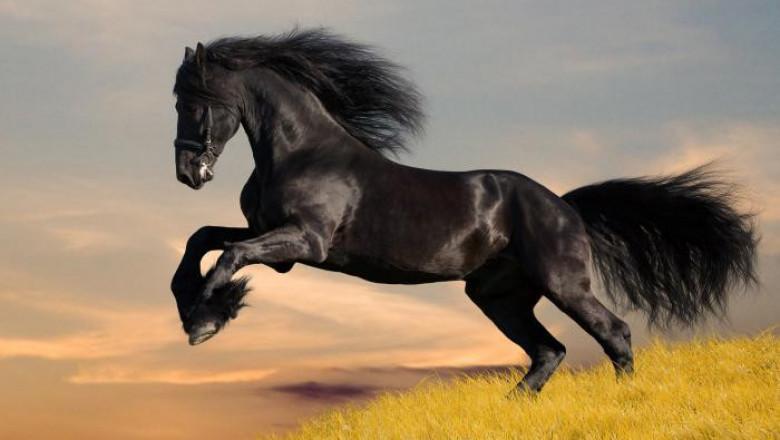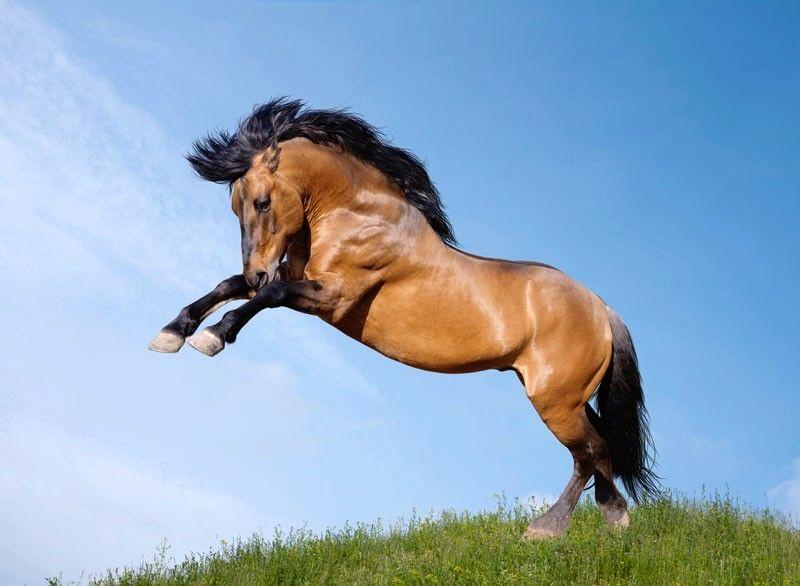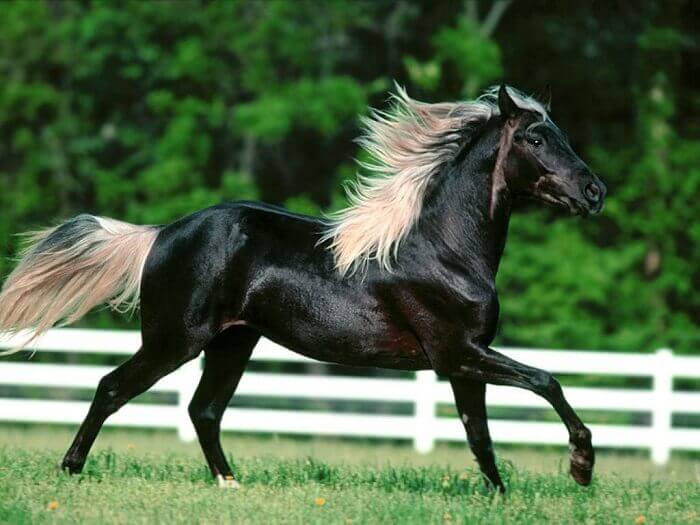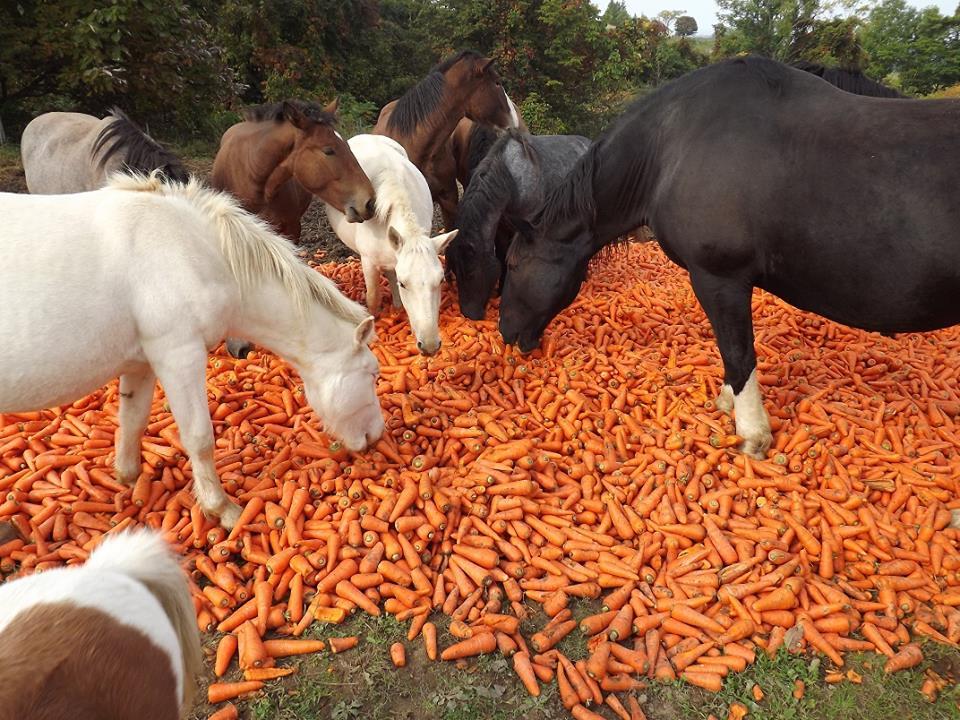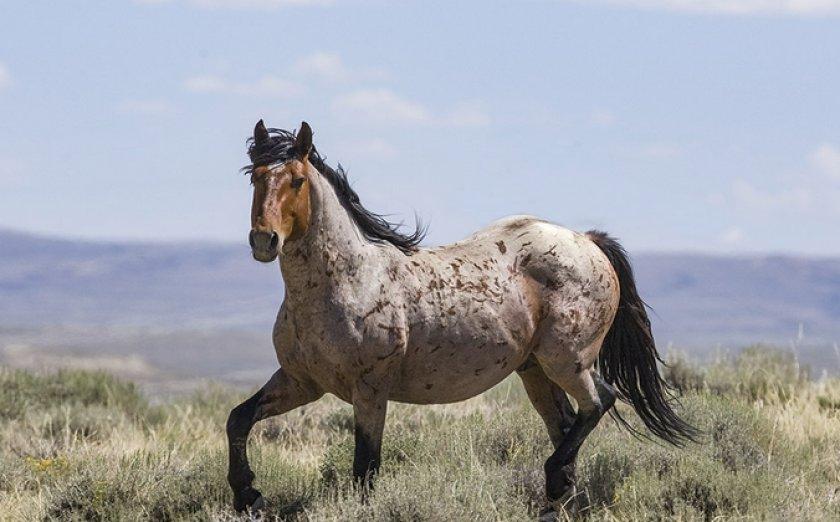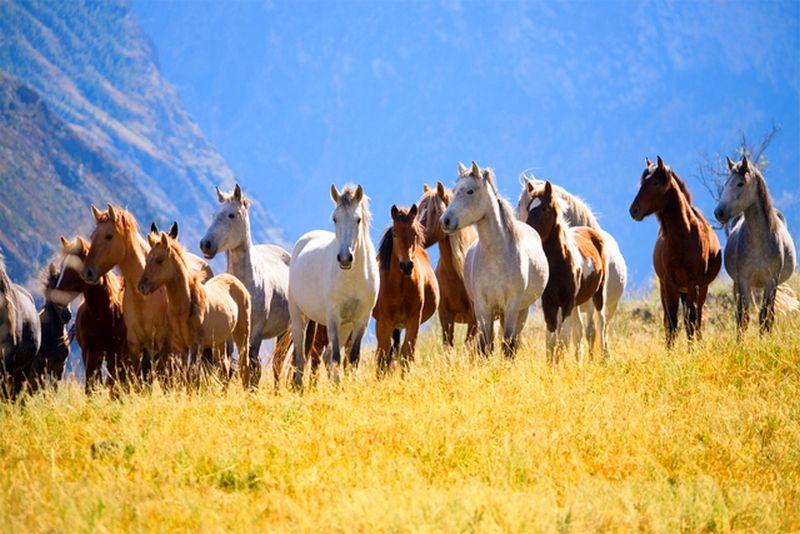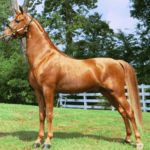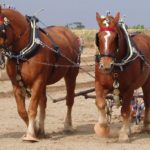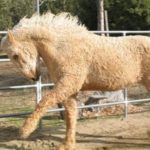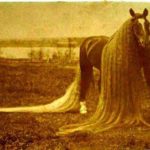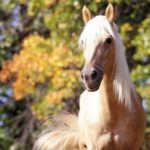It is difficult to meet a person who would not admire wild horses; mustangs inspire delight in their appearance and temperament. The history of these proud animals, which occupied a vast territory for many years and became the hallmark of America, also hides a lot of interesting things. Once people learned to tame mustangs, but only a few succeeded.
- History of the breed
- Mustangs in culture
- Exterior
- Varieties and suits
- White mustangs
- Spanish mustangs
- Russian
- How are mustangs different from domestic horses?
- Lifestyle and intraspecific relationships
- Temperament and disposition
- Diet
- Reproduction
- Natural enemies of the animal
- Is it possible to tame a mustang?
- Interesting facts about wild horses
History of the breed
The homeland of this breed is South and North America. Here, huge herds of proud animals raced across the vast pampas. Scientists have established that the history of these horses goes back to antiquity, but, for unknown reasons, the breed became extinct about several thousand years ago.
After the continent was explored, people started talking about animals again. Conflicts and military skirmishes caused the appearance of wild horses on the prairies - frightened horses ran away, preferring to stay away from humans. The fugitives gathered in herds and actively reproduced, which led to an increase in the population.
Over time, wild horses turned into a valuable hunting object, and the number of horses began to rapidly decrease. Statistics say that about 30 thousand mustangs live in the vastness of America, hunting which is strictly prohibited and punishable by law.
Mustangs in culture
Mustangs have left a bright mark on the culture of the people inhabiting the American continents. Horses symbolized a free spirit and an incredible thirst for freedom. There are many legends that tell that proud animals preferred to throw themselves from cliffs to certain death rather than fall into the hands of humans.
Proud horses are often seen in paintings and photos. Everywhere, mustangs are depicted in a free gallop, with a flowing mane, and with a unique posture. This is another evidence of how these horses are perceived - as rebellious, proud and freedom-loving beauties.
Exterior
Adult horses are not large in size. The height at the withers rarely exceeds one and a half meters. Average weight – 350-380 kg. Thanks to their lightweight build, horses are able to develop incredible speed and cover 50 km in an hour.
The peculiarity of the breed is its incredibly strong skeleton.Mustang bones are often compared to granite.
Varieties and suits
Due to the mixing of blood, mustangs come in different colors. There are black, bay, piebald, and Savras horses. The most valuable are snow-white horses, which can be seen extremely rarely.
White mustangs
White horses are called plain ghosts, they are so elusive and invulnerable. In legends, snow-white horses are endowed with incredible abilities and even almost human intelligence. White horses were held in high esteem by the Comanche Indians; thanks to their incredible color, they were considered worthy of great leaders.
Spanish mustangs
Before Columbus discovered America, this population was small - up to 1 thousand animals. Today, Spanish horses are a great rarity; there are almost none left. Features of the breed:
- straight head;
- short back;
- height – up to 1.2 m;
- proportional forms;
- small ears;
- strong legs.
Horses are distinguished by increased endurance and are capable of covering more than 200 km in one journey.
Russian
They live in the Rostov region of the Russian Federation. There are several versions of the history of the appearance of mustangs on the island of a salt lake located in the Rostovsky Nature Reserve. One version is that the animals originated from a breed of horses popular among the Don Cossacks. The herd is small - only 140-160 heads.
How are mustangs different from domestic horses?
The difference between wild horses and domestic horses is their increased endurance. A wayward character is another distinctive feature of proud handsome men. They also note increased immunity (animals are able to survive in difficult conditions and adapt to harsh climates) and unpretentiousness.
Lifestyle and intraspecific relationships
The lifestyle of mustangs is quite interesting - proud “savages” are distinguished by incredible temperament, complex character and outstanding physical characteristics. Horses have been carefully studied for many years, but even now new facts are being discovered.
Temperament and disposition
The temperament of wild horses was formed in difficult conditions. Thanks to this, horses are characterized by increased energy and some aggressiveness. Not all experienced riders are able to curb the handsome ones - mustangs rarely recognize human leadership.
Horses often openly demonstrate hostility towards humans. The owner is chosen independently, once and for all. Having submitted, the horse turns into a faithful friend. Apart from the owner, the animal will not even allow a familiar person to approach it.
Diet
Wild horses are undemanding when it comes to food. Mustangs feed on leaves of trees and shrubs, grass, and thin tree branches. Tamed horses are transferred to a special diet - a mixture of grass, hay, and grain. The animal eats up to 3 kg of food per day. The mustang's favorite treat is crunchy carrots and sugar. Horses also enjoy eating a slice of bread or an apple.
Reproduction
The mating season for wild horses begins in late spring and continues until early summer. The male wins the female in a tough fight. The winner mates with the coveted beauty, and after 11 months a foal appears. Double offspring are extremely rare in mustangs. For about six months, the baby feeds on mother's milk, then switches to pasture.
Natural enemies of the animal
In the wild, the population has many enemies. Pumas, which are not much inferior in speed to mustangs, are dangerous for horses living in natural conditions.Wolves and coyotes also often try to turn horses into prey, but predators often end up with sick horses or young animals.
Is it possible to tame a mustang?
It is extremely difficult to tame a wild horse. Due to its proud disposition and complex temperament, you will have to spend a lot of effort to turn your horse into a friend. It has been noted that animals raised in captivity are easily tamed, but even in this case there is no guarantee that the proud, handsome animal will submit to humans.
As practice shows, only a few manage to win the trust of a wild adult horse. If it is relatively easy to lasso a savage and transport him to the stables in a special transport, then you have to face incredible difficulties. A horse accustomed to freedom does not recognize a saddle; the taming process will take a lot of effort and require an incredible amount of patience.
Even if you manage to ride a mustang, you will end up with a mongrel horse with modest characteristics. For the sake of fairness, it is worth noting that the horse has high speed, endurance and ease of care. The disadvantages of a tamed horse are a bad temperament that rarely changes, and average athletic performance.
Interesting facts about wild horses
There are many facts related to these animals. Studying legends, myths and fairy tales, confirmed by scientific research, will bring many pleasant moments. It is rare that an animal can compare with the mustang in terms of lifestyle and will to freedom.
The most interesting facts:
- The mustang's worst enemy is man. Animals have been raided for decades; horses have been pursued by all types of transport, including helicopters.Hundreds of horses were destroyed - the skin, which has increased strength, and the large amount of meat made wild beauties a valuable object of hunting. The mass destruction of mustangs stopped after the adoption of the ban and the introduction of criminal liability.
- Mustangs gather in large herds, which always have a leader and a main female. The duty of the male is to guard the herd and protect from enemies. The female is the main “deputy” who has to lead sick animals, young animals and other mares away from the battle.
- When there is increased danger, the herd creates a “circle of death.” Foals, sick and old horses stand in the center, adult horses turn their croup towards the enemy to use a terrible deadly weapon - their hind hooves.
- Young horses live with the herd until they are three years old. After reaching “majority,” the foal is expelled so that it can join a smaller family. Typically, a herd of mustangs consists of 15-25 heads.
- Survival in natural conditions is extremely difficult for mustangs - in areas where wild horses live, it is not easy to find food. In search of food and water, horses travel considerable distances; they often have to win “bread” places in tough battles with other herds.
- To raise a mustang in captivity, you will need a huge area - at least two hectares of pasture per horse. If the area is smaller, the land will quickly deplete and the greenery will completely disappear.
- In the wild, mustangs have learned to switch to energy and strength saving mode, which often happens in winter. There is less food, horses have to forage for roots and fallen leaves and shrubs under the snow; weight loss can only be avoided by reducing energy waste and the ability to accumulate nutrients.
Another interesting fact is that after reaching their third birthday, not all stallions leave the herd. Brave and strong horses grapple with the leader. If they manage to win, they take his place and become the new leader.
Mustangs are the most beautiful animals that inspire delight in their character, appearance, and posture. These rebellious handsome men can safely be called the standard of nobility and grace, a symbol of freedom. As practice shows, a horse can become a best friend, although not every rider has enough patience and strength to achieve the respect and recognition of a wild horse.

